4.5 Forces
1/22
Earn XP
Description and Tags
GCSE Physics Higher Forces
Name | Mastery | Learn | Test | Matching | Spaced |
|---|
No study sessions yet.
23 Terms
Scalar and vector quantities
Scalar quantities have magnitude only. Vector quantities have magnitude and an associated direction. A vector quantity may be represented by an arrow. The length of the arrow represents the magnitude, and the direction of the arrow the direction of the vector quantity.
Examples of scalar quantities include: mass, temperature, speed, distance, energy, time
Examples of vector quantities include: displacement, weight, force, velocity, acceleration, momentum
Contact and non-contact forces
A force is a push or a pull that acts on an object due to the interaction with another object. All forces have both magnitude and direction so forces are vector quantities. Forces are measured in newtons (N). Forces can be divided into two categories, contact forces and non-contact forces.
All forces take place when two objects interact and in the case of contact forces, these objects are physically touching. Friction is an example of a contact force as the force of friction acts between the two objects when they touch. Air resistance is another example of a contact force as when a skydiver falls through the air, air particles collide with the parachute causing the force of air resistance to act upwards. Another contact force is the normal contact force, weight of an object exerts a downward force on the surface that it is on and at the same time the table is exerting an upwards force called the normal contact force. The normal contact force can only happen if the two objects are in direct contact.
In the case of non-contact forces, the two objects are physically separated. An example is gravitational force which attracts all objects to other objects, for example the gravitational force attracts the International Space Station to the Earth and the Earth to the International Space Station. Electrostatic force is another non-contact force, this is the force between two charged objects so objects with opposite charges feel the non-contact electrostatic force of attraction and objects with the same charge feel the non-contact electrostatic force of repulsion. In both cases the two objects are physically separated as the electrostatic force is a non-contact force. Another non-contact force is the magnetic force which is the force experienced by certain objects in a magnetic field.
Gravity and weight
Gravity is a force of attraction between all objects. It is a non-contact force because the two objects do not need to be touching. Like all forces, gravity is a vector quantity as it has both magnitude and direction.
Mass is how much matter an object has inside it. Mass is measured in kilograms (kg). Mass is a scalar quantity as it has only magnitude but no direction. The mass of an object does not change depending on where the object is, for example the mass of an elephant on Earth is the same as its mass on the moon. The weight of an object is the force acting on it due to gravity measured in newtons (N). The weight of an object does change depending on where it is, so an object with the mass of 1kg on the surface of the Earth, experiences a gravitational force towards the centre of the Earth. At the surface of the Earth the gravitational force is 9.8N/kg so an object with mass 1kg has a weight of 9.8N. The gravitational force at the surface of the Earth is known as the gravitational field strength (g). The gravitational field strength is the measure of the force of gravity in a particular location. Objects on the surface of the Earth experience a force of 9.8N for every kg of their mass. The weight of an object is directly proportional to its mass by a scale factor of 9.8. This means that if we double the mass, the weight also doubles. A calibrated spring balance (or newtonmeter) can be used to determine an objects weight. The gravitational field strength of the moon is 1.6N/kg so the same object with mass 1kg still has a mass of 1kg on the moon but has a weight of 1.6N. The weight of an object can be considered to act at a single point which is called the centre of mass.
Resultant forces
A force is a push or a pull that acts on an object due to the interaction with another object. Forces are vector quantities as forces have both magnitude and direction. The resultant force is a single force that has the same effect as all of the original forces acting together.
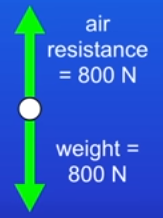
In a free-body diagram the object is shown as a point, the forces are drawn as arrows starting at the point. The length of the arrow shows the magnitude of the force and the direction of the arrow shows the direction of the force.

When an object moves at a constant velocity the forward and backward forces have to be balanced.
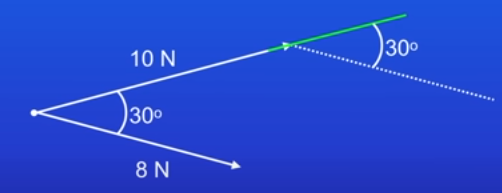

Vector diagram for resultant force of two forces acting at an angle
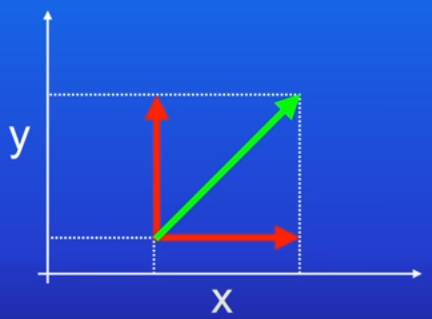
A single force has been resolved into two components, the two components must be at right angles to each other. We can do this for any force and if the diagram is to scale we can determine the magnitude of the horizontal and the vertical components.
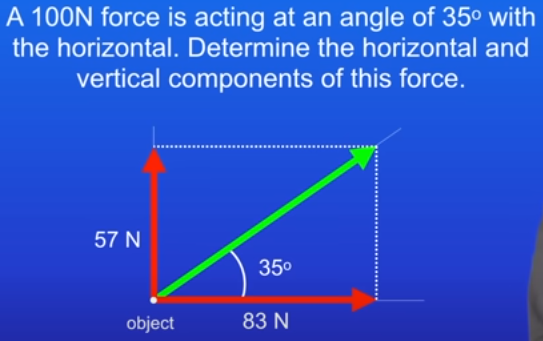
Work done and energy transfer
Work is when energy is transferred while a force is used to move an object, for example chemical energy from muscles or fuel, to thermal and kinetic energy. Work is measured in joules (J). I newton-metre of work = 1J. When a car brakes, the brake presses against the wheel where the force of friction acts between the brake and the wheel transferring the kinetic energy store of the car to a thermal energy store of the brakes. The temperature of the brakes increases and the car slows down as it loses kinetic energy. When a person walks up some stairs the distance travelled up (m) x their weight (N) is the work done (J). This is because the distance must be in the line of action of the force and because weight is acting vertically downwards, only the vertical height travelled matters. The person's chemical energy store is transferred to their gravitational potential energy store.
Forces and elasticity
Rubber bands, rubber glover, erasers, playground surfaces, and tennis balls are all elastic materials. An elastic material is a material which will always return to its original length and shape if the forces acting on it are taken away. Temporary changes in shape when an elastic object has a force applied to it are called elastic deformation. In order to change an object's length or shape, more than one force has to be applied otherwise the forces won't be balanced and the object would simply move rather than changing length or shape. When inelastic materials are stretched they don't return to their original length or shape when the forces are removed. Changes like this are called inelastic deformation. Examples of inelastic materials include certain polymers such as PVC or polystyrene. When an object is stretched or compressed, a force is used to do work and elastic potential energy is stored in the object. As long as the object is not inelastically deformed, the work done is equal to the elastic potential energy.
Moments
The turning effect of a force is called the moment of the force. Moment is measured in newton-metre (Nm). When calculating a moment, the distance has to be perpendicular from the line of action of the force to the pivot.
When two people are sitting on a seesaw, they are each applying a moment due to their weight. The person on the right is applying a moment acting in the clockwise direction, this is called the clockwise moment. The person on the left is applying a moment acting in the anticlockwise direction, this is called the anticlockwise moment. Because the seesaw is balanced, the clockwise moment is equal to the anticlockwise moment, so the force x distance in the clockwise direction is the same as the force x direction in the anticlockwise direction. This can be used to calculate either the force or the distance from the pivot. This idea can be used to explain why certain objects topple. The weight of an object acts directly downwards from the centre of mass and as the block is tilted the line of action falls outside the base of the object and at this point there is a resultant or unbalanced moment acting on the block causing it to topple.
Levers and gears
Examples of levers include, a hammer used to remove a nail and a crowbar to lift a plank of wood. Both the hammer and the crowbar transmit the turning effect of the force from one side of the pivot to the other. Leavers are force multipliers.
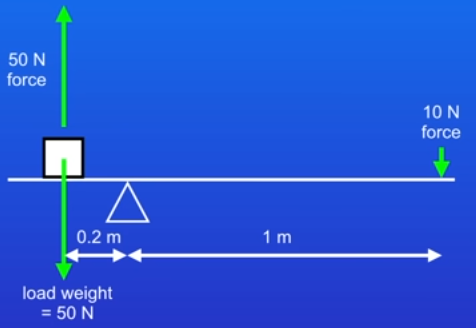
As shown in the diagram, levers allow us to lift a heavy load by applying a relatively small amount of force. The lever in the diagram has multiplied the force by 5x. The moment on the right is 10Nm and the moment on the left is also 10Nm so they are equal so the lever allows the box to be lifted with 10N of force.
Gears can also transmit the turning effect of a force, gears can be found in lots of different machines including cars.
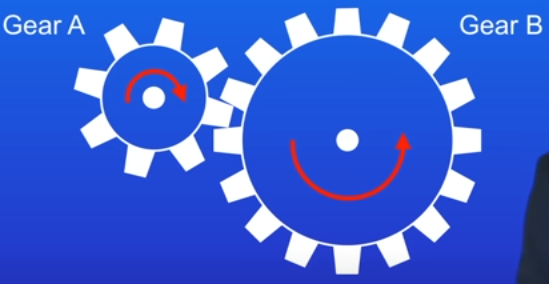
If gear A is connected directly to the turning force of an engine and gear B is connected directly to some wheels, the gear system will transmit the turning force from the engine to the wheels. When gear A turns it applies a force onto gear B. The turning effect depends on the distance between the edge of the gear and the centre. Because gear B has twice the radius of gear A, the turning effect of gear B is twice as large as that of gear A meaning the turning effect of the engine has been doubled as it is transmitted to the wheels. Gear A rotates twice every time gear B rotates once, meaning the work done by the two gears is the same.
Pressure and pressure differences in fluids, atmospheric pressure, floating and sinking
Particles in a gas are widely spaced and moving rapidly, and they collide with each other and the walls of the container. When particles collide with the walls they exert a force against it which is acting at right angles (along the normal). The pressure in fluids causes a force normal (at right angles) to any surface. Particles in a liquid act similarly in the sense that they also exert a force at right angles to the walls of the container. A fluid can be either a liquid or a gas. Pressure is measured in pascals (Pa). The atmosphere is a thin layer of air around the Earth and it is most dense at the surface of the Earth, so at the surface there are the greatest number of air molecules in a given volume. The atmosphere gets less dense as we increase the altitude. Pressure is caused by air molecules colliding with the surface so as the altitude increases the number of air molecules above the surface decreases so atmospheric pressure decreases with an increase in height. This means that when airplanes are flying the air pressure in the cabin is kept at a slightly lower level than the air pressure on the ground so the air pressure inside a bag of crisps is greater than outside the bag so the bag inflates. Because atmospheric pressure decreases as you increase altitude, mountain climbers take supplies of oxygen with them as the air pressure on a mountain can be too low to supply all of the oxygen needed.
Pressure of a liquid increases with depth as there is a greater weight of liquid acting downwards. Pressure of a liquid also increases with the density of a liquid as liquids with a greater density have a greater weight acting downwards.
As pressure in a liquid increases with depth, an object submerged in water has a higher pressure on the bottom than on the top because the bottom of the object is at a greater depth. This means that there is a larger force acting on the bottom of the object than the top so there is a resultant force acting upwards. This force is called upthrust. For an object to float, the upthrust must equal the object's weight so if the upthrust is less than the weight then the object sinks. When an object is lowered into water, the water level will rise because the object will displace the water. The weight of water displaced is equal to the size of the upthrust acting on the object so if an object can displace its own weight of water, the upthrust will equal the objects weight and the object will float. An object less dense than water only has to displace a small volume of water before the weight of water displaced equals the weight of the object. An object with the same density as water must displace its own volume of water for the weight of water displaced to equal the weight of the object, but when it floats, the surface of the object is at the surface of the water. An object more dense than water cannot displace a volume of water equal to its own weight and therefore the weight of the object is greater than upthrust so the object sinks.
Distance and displacement
Distance is how far an object moves. Distance does not involve direction. Distance is a scalar quantity. Displacement includes both the distance an object moves, measured in a straight line from the start point to the finish point and the direction of that straight line. Displacement is a vector quantity.
Speed
Speed is the distance travelled by an object in a given time. Speed does not involve direction, only distance so speed is a scalar quantity.
Normal walking speed is around 1.5 m/s
Running speed is around 3 m/s
Cycling speed is around 6 m/s
Car on main road is around 13 m/s and on a motorway is 30 m/s
Fast train is around 50 m/s
Cruising airplane is around 250 m/s
Speed of sound in air is 330 m/s
Velocity
The velocity of an object is its speed in a given direction. Velocity is a vector quantity because it includes both magnitude and direction. Velocity has the same calculation as speed but must also include the direction.
A special case of velocity is for objects moving in a circle. Although an object may be at a constant speed, the direction is constantly changing, so its velocity is constantly changing.
Distance-time graphs
If an object moves along a straight line, the distance travelled can be represented by a distance-time graph. The gradient of a distance-time graph is the speed. For a distance-time graph showing acceleration, find a tangent at the time asked and then draw a tangent as big as possible and the gradient of the tangent is the speed at the specific point.
Acceleration
Acceleration is the change in velocity over a given time.
Acceleration is measured in m/s2. An object that speeds up is accelerating and an object that slows down is decelerating.
The acceleration of an object can be calculated from the gradient of a velocity–time graph.
(HT only) The distance travelled by an object (or displacement of an object) can be calculated from the area under a velocity–time graph.
Near the Earth’s surface any object falling freely under gravity has an acceleration of about 9.8m/s2. As the object continues to fall it experiences air resistance and after some time the force of air resistance balances with the force of gravity at which point the object stops accelerating and has reached terminal velocity. An object falling through a fluid initially accelerates due to the force of gravity. Eventually the resultant force will be zero and the object will move at its terminal velocity. Air resistance depends on an objects shape, some objects will reach a greater terminal velocity because they have a greater mass so they have a greater downward force of weight, but also because they are more streamline/aerodynamic so they experience a smaller upwards force of air resistance.
As soon as a skydiver jumps out of a plane, the only force acting is weight, this is due to gravity. Because of weight the skydiver experiences a resultant force acting downwards so they accelerate towards the ground. As the sky diver falls, they experience friction with air molecules, i.e. air resistance. Air resistance acts upwards however the weight is still greater than the air resistance so the skydiver continues to accelerate towards the ground. As the skydiver's velocity increases, the air resistance also increases and at a certain point the air resistance balances the weight so there is no resultant force and the velocity stays constant. This is the maximum velocity the skydiver will reach and it is called the terminal velocity. The terminal velocity is extremely high and if the skydiver hit the ground they would likely die so to slow them down the skydiver, opens a parachute which massively increases the surface area causing the air resistance to also massively increase. At this point the air resistance is greater than the weight so there is a resultant force acting upwards causing the skydiver to decelerate and their velocity decreases. Because their velocity has decreased, the air resistance also decreases and eventually the air resistance and weight balance out so the resultant force is 0, this means that the skydiver is falling at a lower terminal velocity which is safe for them to hit the ground.

Newton’s first law
Newton’s First Law: If the resultant force acting on an object is zero and the object is stationary, the object remains stationary. If the resultant force acting on an object is zero and the object is moving, the object continues to move at the same speed and in the same direction. So the object continues to move at the same velocity. So, when a vehicle travels at a steady speed the resistive forces (such as friction with the air and friction with the road) balance the driving force. So, the velocity (speed and/or direction) of an object will only change if a resultant force is acting on the object.
(HT only) The tendency of objects to continue in their state of rest or of uniform motion is called inertia.
If resultant force acts on a stationary object, the object accelerates. If resultant force acts in the opposite direction of travel on an object moving at a constant speed, the object decelerates. A resultant force can also make an object change direction
Newton’s second law
Newton’s Second Law: The acceleration of an object is proportional to the resultant force acting on the object, and inversely proportional to the mass of the object.
Cars travel at around 13 m/s on a main road and 30 m/s on a motorway. To accelerate from a main road to a motorway, the typical acceleration is 2m/s2. For a typical family car, this would require a force of around 2000N of energy.
Inertial mass is a measure of how difficult it is to change the velocity of an object. Inertial mass is defined as the ratio of force needed to accelerate an object over the acceleration produced. An object with a large inertial mass would require a large force to produce a given acceleration than an object with a smaller inertial mass.
Newton’s third law
Newton’s Third Law: Whenever two objects interact, the forces they exert on each other are equal in magnitude and opposite in direction.
Examples of Newton's third law in practice include: in rowing, when you push water with a padel, the water pushes back on the padel with a force equal in magnitude but opposite in direction. When a skateboarder jumps off of a skateboard pushing it to the right, the skateboard exerts a force on the skateboarder that is equal in magnitude but opposite in direction so the skateboarder is pushed to the left. When a rocket fires, a chemical reaction produces a downward push force on the hot exhaust gases, which exert an equal force on the rocket but acting in the opposite direction (upwards). When a car is driving, the wheel exerts a force in the reverse direction on the road and at the same time the road exerts a force in the forward direction on the wheel, these two forces are equal in magnitude but opposite in direction.
Stopping distance
The stopping distance of a vehicle is the sum of the distance the vehicle travels during the driver’s reaction time (thinking distance) and the distance it travels under the braking force (braking distance). For a given braking force the greater the speed of the vehicle, the greater the stopping distance. Breaking distance can also be affected by certain factors, such as wet or icy conditions which reduce friction between the tyres and the road increasing breaking distance. The breaking distance will also increase if the car has worn tyres as this reduces the friction between the tyres and the road. Worn brakes also increase the breaking distance.
Reaction time
Reaction times vary from person to person. Typical values range from 0.2 s to 0.9 s. A driver’s reaction time can be affected by tiredness, drugs and alcohol. Distractions such as mobile phones may also affect a driver’s ability to react. Reaction time can be measured by holding a rules between the fingers of a person and the ruler is dropped at a random time and the person has to try and catch it with their fingers. The further the ruler falls before it is caught, the longer the reaction time. By measuring how far the ruler fell, we can look up the reaction time on a table or database. It is important for a driver to have a quick reaction time so if they need to suddenly stop, for example if they see an obstruction, they can do so as quickly as possible. Because all of these factors increase the reaction time, they also increase the thinking distance and therefore the stopping distance.
Forces in braking
When a force is applied to the brakes of a vehicle, work done by the friction force between the brakes and the wheel reduces the kinetic energy of the vehicle and it is converted to thermal energy in the brakes, causing the temperature of the brakes to increase. Because the car loses kinetic energy it slows down. The greater the speed of a vehicle the greater the braking force needed to stop the vehicle in a certain distance. The greater the braking force the greater the deceleration of the vehicle. Large decelerations may lead to brakes overheating and/or loss of control.
Momentum as a property of moving objects
All moving objects have momentum, but if an object is not moving, then its momentum is 0 i.e. objects that are not moving have no momentum. The unit of momentum is kg m/s.
Conservation of momentum
In a closed system the total momentum before an event is equal to the total momentum after the event. If a van is travelling towards a stationary car, the van has momentum and the car does not. If the van collides with the car both the van and the car move together at a lower velocity than the initial velocity of the van. The total momentum of the van and the car is now the same as the initial momentum of the van by itself so the total momentum before the collision is the same as the total momentum after the collision so all of the momentum has been conserved. Another example is between a cannon and a cannonball. Before the cannonball is fired, both the cannon and the cannonball are not moving so their momentum is 0. When a cannon fires, the cannonball is moving at a very large velocity so the cannonball has momentum acting in the forward direction. At the same time, the cannon recoils backwards so the canon has momentum acting in the backwards direction. The backwards momentum of the cannon is equal to the momentum of the cannon in the forward direction so the total momentum after firing is 0.
Changes in momentum
When a force acts on an object that is moving, or able to move, a change in momentum occurs. Rapid changes in momentum lead to huge forces applying and these can be extremely dangerous and even lethal. This danger can be reduced if we make a change in momentum happen over a long time. Air bags, seat belts, gymnasium crash mats, cycle helmets and cushioned surfaces for playgrounds all slow down the momentum change reducing the forces acting and therefore reduces the risk of serious injury.